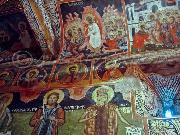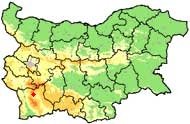Church St Teodor Tiron and Teodor Stratilat
"St.Teodor Tiron and Teodor Stratilat" church in Dobarsko was built in 1614. Most likely it was built on the foundations of an existing church from XII century (year of 1112) church, which can be deduced by an inscription on the slab dug into the floor before the altar (there are theories that at this place there was a religious object in more earlier times - VIII - IX century).
The temple is small (8,37 x 6,50 x 5,20 meters), built as a three-aisled basilica of stone and mortar. It was constructed observing the Turkish law from that time, according which it was forbidden the Christian religious sites to rise higher than the Muslim and externally they must look a residential building. Therefore, the church was half dig in the ground, without a belfry and cupola, with small windows.
By contrast of its outside look, the church impresses with its rich interior decoration and bright and beautiful murals. On very small area are painted a very large number of icons, including more than 30 of women saints. Such large number of female icons is unusual for the other churches where this number is not greater than 10.
Another feature of the church are the images of weapons and ships. The Saints-warriors are painted with weapons such as halberds and helmets, which are typical for the western European arsenal of that time, but not for the Bulgarian lands. Also, the ships strikingly reminiscent of the Venetian galleys.
Undoubtedly, one of the most unique and interesting image in the church of St. Teodor Tiron and Teodor Stratilat is that where is painted Jesus arriving on earth with something looking like a rocket. This is the only image of this kind in the world and is still a mystery for the scientists and experts.
Many visitors of the church, maintain the thessis that the place radiate a strong positive energy due to its unique combination of location, icons, murals, time and events occurring in the region.
Nowadays the church is among the cultural monuments protected by UNESCO and one of the 100 national tourist sites of Bulgaria. It does not conduct religious services but is open to visitors.








